Fuck Image
massa critica | davide tommaso ferrando
This is the second chapter (read the first and third) of my essay on Architecture Criticism in the Age of Social Networks, which I presented in the frame of the critic|all conference (ETSA Madrid, June 2014), and am now publishing in a three-parts, web-friendly edition on OII+. Here, I briefly discuss the importance of images in actual architectural production, proposing to use them as tools for architecture criticism as well. Comments and suggestions are more than welcome! DTF
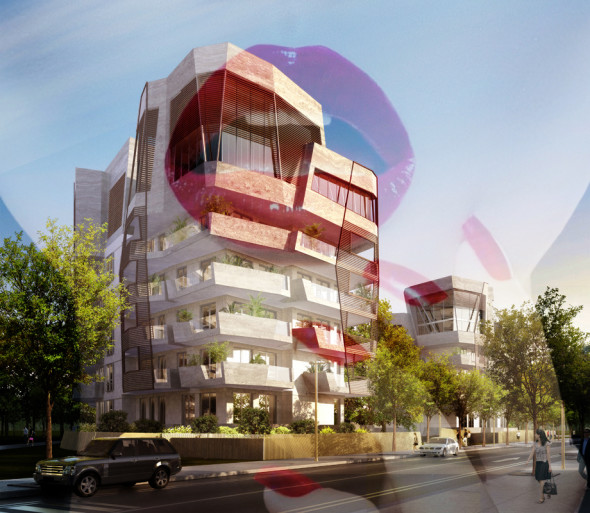 Milano to Kiss
Milano to Kiss
The cultural relevance of the image for modern society has been greatly described by Guy Debord in his 1967 essay The Society of the Spectacle, where he states that «The whole life of those societies in which modern conditions of production prevail presents itself as an immense accumulation of spectacles. All that once was directly lived has become mere representation. […] Understood in its totality, the spectacle is both the outcome and the goal of the dominant mode of production. […] The spectacle is capital accumulated to the point where it becomes image»1. More recently, Neil Leach has insightfully analysed the way in which the removal and substitution of reality with a world of autonomous images can produce critical consequences in the field of architecture: «While aestheticization remains a background cultural condition that permeates […] the whole of present society, its effects will be all the more marked within a discipline that operates through the medium of the image. Architecture is fully ensnared within this condition»2. According to Leach, the privileging of the image leads to an impoverished understanding of the built environment, as it empties architectures of much of their original meanings by fetishizing them and shifting judgement on their surface appearance at the expense of deeper readings, eventually trapping architectural discourse within the whole logic of aestheticization.
In recent years, such condition has been exacerbated even further by the widespread of web media bombarding us with continuous streams of information, which generate an inundation of texts and images that, paradoxically, has the effect of dispersing knowledge, rather than accumulating it, being that too much information equals no information – or, to put it with Baudrillard’s words: «where there is more and more information there is less and less meaning»3. Today, information overload is experienced as a distracting and unmanageable flux of web contents, which exceeds our cognitive capacity through constant interruptions (new emails, blog entries, social networks notifications, Skype calls, etc.) that narrow down our attention span and decision accuracy, producing a state of distracted perception fundamentally characterized by «experiences of fragmentation, shock and dispersal»4.
In a context of constantly shifting and rapidly decaying attention, the web becomes an excellent medium for the transmission of instantaneous, fast consumable and appealing architectural images that, distractedly received by the average reader, end up exhausting themselves in the process of communication, eventually offering nothing more than confused visual stimuli to be immediately replaced by new ones. Alarmingly, very few people seem to realize to what extension this superficial system of communication is affecting architecture as such.
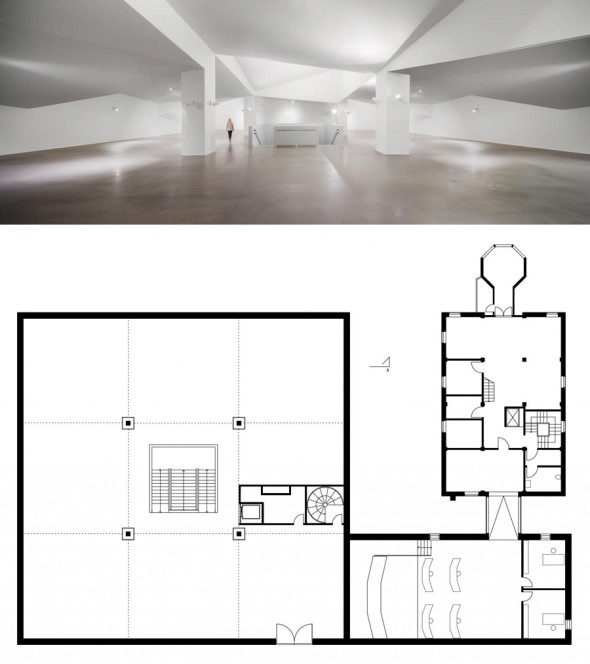 COBE, Maritime Museum, 2013
COBE, Maritime Museum, 2013
I’ll make an example. Recently, I casually found out that the main picture of the exhibition space of COBE’s new Maritime Museum in Porsgrunn (Denmark) – published on the issue n.48 of “MARK” (pp. 100-103) as well as on globally read web platforms like Archdaily, Designboom, Dezeen, Plataforma Arquitectura and Archinect – is actually a fake. The portrayed white open space covered by a variously pitched roof, in fact, simply doesn’t exist, or better, it is not continuous but interrupted by a service volume that should appear on the right side of the picture, hadn’t it been carefully removed from the image with some digital program in order to provide the represented space with an artificial sense of symmetry and continuity. Uncovering the deception wasn’t hard: I just had to compare the photograph of the exhibition hall with the museum’s floorplan: a basic and elementary reading activity that, apparently, isn’t just as practised as it should.
To me, this anecdotal example is highly representative of the degree of mystification that permeates architectural communication (actually since the 1990s, when the first programs for digital retouch came into use in architecture practices). In the production of press releases, images can be easily manipulated by both architects and photographers, not only to omit disturbing facts (no one compels you to show the less convincing parts of your design), but also to lie about them (decency is the only limit to digital retouching). Just like in advertisement, architecture images have abandoned reality to become an end in themselves: a thin digital layer that saturates our spatial perception of fallacious models (that we rarely replace with personal experience), and that flattens architectural discourse down to a matter of pure visibility, eventually becoming the final goal of architectural design5. In the “perfect crime” of the XX century, the “institution of the real” has been definitively removed from architectural discourse, leaving us «with a world of images, of hyperreality, of pure [architectural] simulacra»6. In the age of social networks only the image speaks, because it’s only the image we pay attention to.
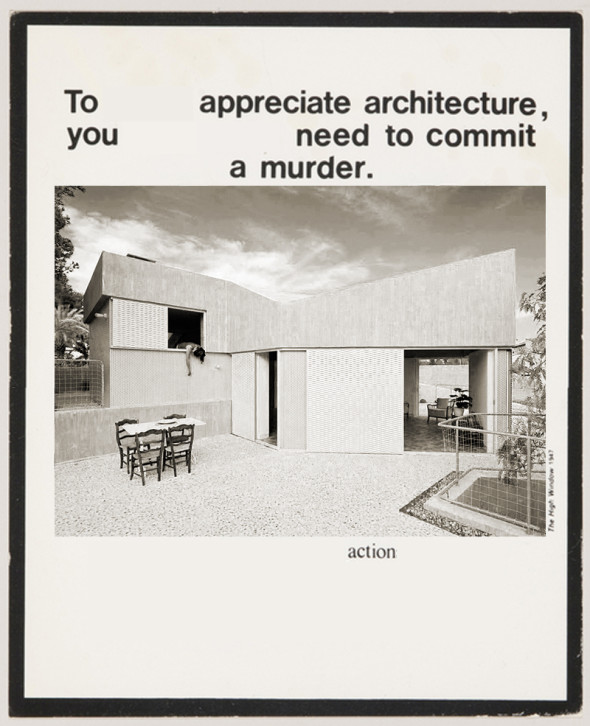 Architectures for Advertisement [to appreciate architecture you need to commit a murder]
Architectures for Advertisement [to appreciate architecture you need to commit a murder]
This epistemological shift has profound consequences on the way both architecture and architecture criticism are defined. The strategic system of texts, images and videos with which projects are being communicated, in fact, shouldn’t be considered as something accessory to what we traditionally call “architecture”: on the contrary, they define it as much as bricks and mortar, because in the information age they are highly (when not solely) responsible for the way in which we understand built reality. Since the XVIII century, architecture got enriched, at a constantly accelerating pace7, of (written and visual) representations that have become part of our architectural imaginary in the same manner as real buildings: the word “architecture”, in this sense, doesn’t simply define a body of theories and works, but a cultural landscape made of constructions, writings and images, of their mutual relations and of their personal and collective interpretations. Who doesn’t recognize the importance of this multidimensional character of architecture, doesn’t understand its actual complexity.
Now, if the complexity of a critique is supposed to be proportional to that of its object, it seems at least fair to postulate that, in the information age, architecture criticism should not regard exclusively ideas and buildings, but also the widest system of representations (all the writings, images and videos) that participate in the complex definition of today’s idea of “architecture”, as they too are imbued with ideologies that need to be demystified. But what tools can critics adopt to criticize projects that are essentially thought and transmitted as images, having to deal with a system of digital media that tends to privilege the instantaneousness of visual over written communication?
 Blue Salerno
Blue Salerno
The answer to this question can be found in the history of criticism, and more specifically in the theories of Friedrich Schlegel who, in his studies on Lessing, stated that the source and object of criticism should belong to the same discipline: «Poetry can only be criticized by poetry. A judgement on art that is not itself art has […] no civil rights in the realm of art»8. Similarly, in the 1960s Bruno Zevi has suggested that criticism should borrow the means intrinsic to architecture – drawings and scale models – to the detriment of written criticism, which according to him was an inefficient medium for architects. Two decades later, also Wayne Attoe proposed to broaden the instruments of criticism to those of architecture, maintaining that «One can make distinctions, sift, describe, explicate and interpret in a laboratory or studio, and with a camera or felt-tip marker as easily and usefully as at a typewriter. Criticism should be viewed in terms of tactics and intentions, not in terms of the media employed»9.
In an age when both architectural design and communication are dominated by images, it seems only natural to propose that criticism should adapt itself to the new representational status of architecture (instead of simply disqualifying it for the sake of the “good old times”), by turning the same visual tools that designers use to promote their works against them. Indeed, not only images could be more adequate than words to reveal the economic content of current architectural tactics, but the mechanisms of web publication – fast reading, relevance of the image, easiness of association, informality, viral propagation, etc. – definitively make them the most efficient medium of communication.
However, I do not mean to declare written criticism dead: quite the opposite, I am rather suggesting that today, in order not to be excluded from the real places of communication, criticism should enrich itself by experimentally recurring to the visual tools offered by the web and the social networks, whose features do not admit a “classic” approach to critical discourse, but open a range of – for the moment underestimated – communication possibilities that are principally based on iconographic association, following the path already opened by Aby Warburg’s atlases and Colin Rowe’s double slides.
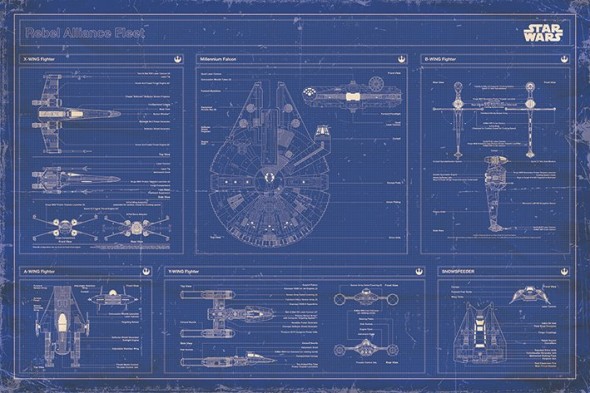 Star Wars Rebel Alliance Fleet
Star Wars Rebel Alliance Fleet
Books, magazines, websites and social networks are different media that follow different rules of communication, and therefore can host different kinds of architecture criticism (a word that clearly doesn’t define a unique practice or type of discourse). Given the mentioned complexity of contemporary architecture, it doesn’t seem necessary – or possible – that each critique covered the entire criticizable spectrum: critiques can also be partial, as long as they are structured in a coherent and efficient way. The web and the social networks, in this sense, are excellent media where to develop a “minor” kind of criticism – one that is visually appealing, instantaneously comprehensible, clearly demystifying and potentially viral –, which should nevertheless be complemented by “classic” written critiques, more conveniently publishable on traditional media such as paper magazines and books, where the distraction rate is lower and the possibility for constructing complex thoughts is higher. Just like a naval fleet is composed of different ships with different tasks that collaborate to reach one same goal, architectural discourse can take advantage of all the communication media that are at disposal today, by capitalizing each one’s specific characteristics.
Davide Tommaso Ferrando
Notes:
1. DEBORD, Guy. The Society of the Spectacle. Zone Books, New York, 1994.
2. LEACH, Neil. The Anaesthetics of Architecture. The MIT Press, Cambridge/London, 1999, p. 9.
3. BAUDRILLARD, Jean. Simulacra and Simulation. University of Michigan Press, Ann Arbor, 1994, p. 79.
4. CRARY, Jonathan. Suspension of Perception. Attention, Spectacle, and Modern Culture. The MIT Press, London/Cambridge, 1999, p. 1.
5. I remember a friend of mine (and a very good architect) telling me, during a visit to one of his building sites, that although the project had some weak parts, he was more than satisfied with it, because he could foresee some of the pictures that the photographer was going to take as soon as the construction was completed, and he liked them very much. He told me: «having two or three beautiful images to show: that’s what’s important».
6. LEACH. Op. cit., p. 5.
7. Especially in the last decades, the presence of architecture in both specialized and non-specialized media has grown exponentially and at an unprecedented rhythm. This known phenomenon, which is also a consequence of the globalization and digitalization of communication, is highly representative of the recent transformation of architecture in one more commodity. From the moment it stopped being linked to the production of necessary objects, in fact, architecture had to enrich itself of a rhetorical dimension made of commercial representations (of which buildings can be either the object or the background) aimed at guaranteeing its survival and replication through the generation of a collective desire towards its images.
8. In BÜRGER, Peter. Definitions and Limitations of Criticism. In “OASE” n. 81, June 2010, p. 16.
9. ATTOE, Wayne. Architecture and Critical Imagination. John Wiley and Sons, Chichester/New York/Brisbane/Toronto, 1978, p. 16.
Related Posts
Questo sito usa Akismet per ridurre lo spam. Scopri come i tuoi dati vengono elaborati.

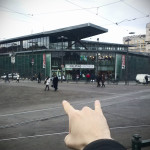
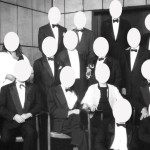





Lascia un commento